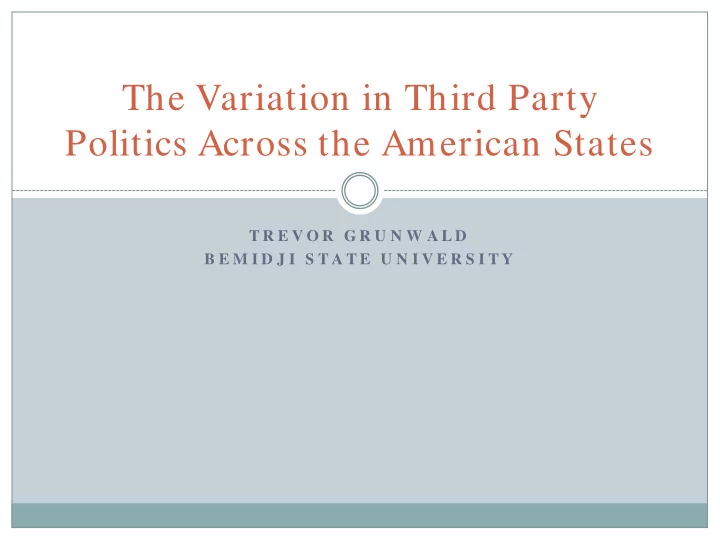

The Variation in Third Party Politics Across the American States T R E V O R G R U N W A L D B E M I D J I S T A T E U N I V E R S I T Y
Third Parties Governor Jesse Ventura Ross Perot Presidential Candidate Texas Minnesota
Background My interest was piqued as a little kid in 1998 when Jesse Ventura was elected Governor of Minnesota. I personally think that a viable third party is needed in today’s America. I wanted to set out to see where this third party may stem from.
Topics of discussion We will look at ballot access issues, competitiveness within the states, political culture, campaign finance, and my self created acceptance scale.
Previous Research Daniel Elazar’s Political Culture of the United States Study is some past research that has been done before in this area Richard Winger’s The Im portance of Ballot Access
Methods I constructed my data from many different sources. I obtained a list showing the requirements to become a fully fledged party in all 50 states. Also found competitiveness numbers on State House races I used States data on SPSS for some of my research Constructed a formula for acceptance level for third parties in the states
Methods (continued) I created bar charts, scatter plots, and coded maps made on paint for the states.
Ballot Access Third Parties at a distinct disadvantage Different requirements in each state for ballot access and Party status Some States have no requirements others have very hard and strict requirements I wanted to see what the data from a decently popular third party Presidential candidate would look like so I used Ralph Nader as a model. I studied where he was most successful compared to gaining party status in the states.
Findings
Political Culture 3 Categories Moralistic (clean politics, common people involved in politics) Individualistic ( common people usually aren’t involved in politics, corruption is more common) Traditionalistic ( middle road between moralistic and individualistic, more common in the southern states ran by the elite or southern gentlemen “The good ol boys”)
Political Culture Map
Findings
Competitiveness I looked at competitiveness of State House races in the all of the states. I used this data to try and find out if certain states are ruled by a certain party, which would be a bad thing for third parties. One thing associated with this is campaign finance, it should be noted that not all states have equal campaign finance laws. The better the system in a certain state more often then not this leads to more competition between candidates.
Findings
Acceptance Scale I created a scale to try and rank all of the states on their probable acceptance to third party candidates. The scale takes into account the difficulty of attaining ballot access and the overall competitive nature of the states politics. Formula is percent of signatures needed in last presidential vote to gain party status in each respective state plus ten times the percent of state house races that were not competitive divided by 10. An example Minnesota would be 5+10=15*43=645/ 10=64.5 state score which is a very good score. Scores range from about 30- 130 lower score more acceptance
Findings
State Acceptance Map
Conclusion In the beginning my findings were almost exactly opposite of what I expected. The states that one would think would be the most friendly were actually scoring the lowest. Until I put in place my acceptance scale this formula really emphasizes competitiveness. Interesting thing about this is that the states that were most competitive were also states that are known to have some of the best public financing options in the United States.
Conclusion (continued) Some of these states with good public financing options include Arizona, Minnesota, and Maine. All of these states scored very well on my acceptance scale which would lead me to believe that public financing money is a big indicator of third party success. Not to mention good competition in a state between the major two parties seems to be good for third parties.
Future areas of Study Fusion the idea of smaller parties joining with a larger party to pool their votes, allows third parties to have effect on major parties platform IRV (Instant Runoff Voting) Allow people to rank their candidates thus letting them feel as if they are not wasting their vote on third party candidate
Recommend
More recommend